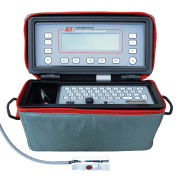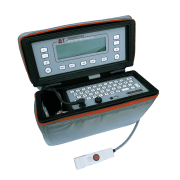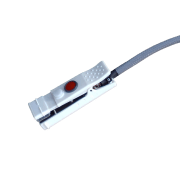- Overview
- Specification
- Accessories
- Product Resources How to Buy
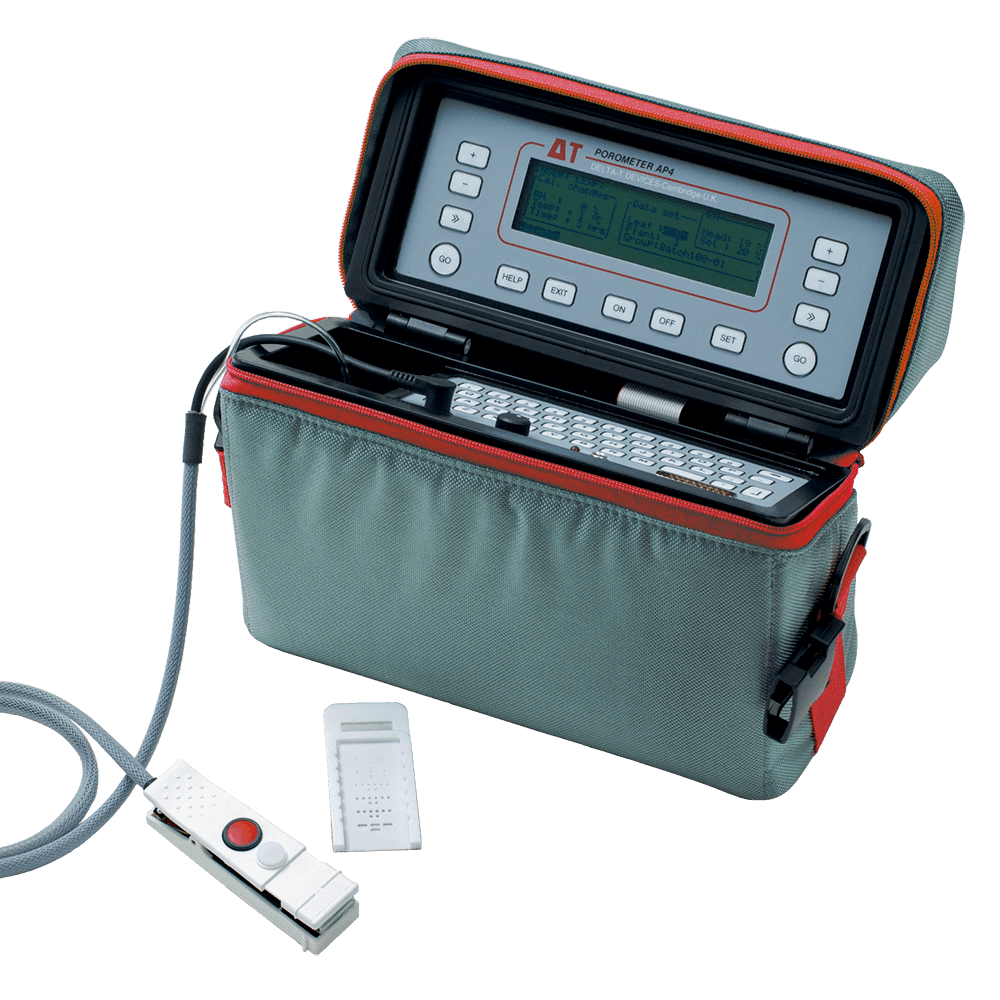
Testimonials
 Direct readout of stomatal conductance or stomatal resistance
Direct readout of stomatal conductance or stomatal resistance - Simple absolute calibration in the field
- Minimises leaf stress during measurement
- Ideal for phenotyping based research
- Award winning user interface
- 5 year warranty
Stomatal aperture is the dominant factor in the diffusion conductance of leaf surfaces, which controls both the water loss from plant leaves and the uptake of CO2 for photosynthesis. Measurements of diffusion conductance are therefore important indicators of plant water status and provide a valuable insight into plant growth and plant adaptation to environmental variables.
Video – Introduction to the AP4 Porometer
AP4 Leaf Porometer features
The AP4 Leaf Porometer measures diffusion conductance by comparing the precise rate of humidification within a small cuvette (chamber) to readings obtained with a calibration plate. The plate has 6 diffusion conductance settings whose values have been accurately determined by finite element analysis.
Quoted accuracy figures for other porometers and gas analysis systems are based on time-consuming laboratory set-up and calibrations which bear little comparison to field conditions. In contrast, the AP4 Leaf Porometer features simple direct calibration in the field against a tested physical standard.
The AP4 Leaf Porometer has many other features designed to ensure that accurate, reproducible readings can be taken as easily as possible:
- Sophisticated temperature compensation
- Unstirred leaf chamber minimises unwanted stomatal closure
- Lightweight ergonomic sensor head
- Large clear LCD display (8 lines by 40 characters)
- Full QWERTY keypad for annotating up to 1500 readings
- A rugged and reliable tool for phenotyping projects
- Over 2,000 Delta-T porometers in use worldwide
Porometer design collaboration with Prof John Monteith
Delta-T Devices worked closely with Professor John L. Monteith (1929 – 2012) over a period of four decades – from manufacture of the world’s first automatic porometer in the 1970s, through several subsequent versions – leading to the current AP4 Porometer.
Delta-T Devices Founder, Ed Potter, shared a platform with a number of speakers to pay tribute to Professor John L. Monteith at the 2013 American Society of Agronomy Annual Meeting in Tampa, Florida. The talk included a history of the development of the automatic porometer.
View a video of Ed Potter’s presentation here
Dynamic diffusion porometers, such as the AP4, are also known as stomatal diffusion porometers.
Specification
| Parameter | Reading range | Resolution [1] | Accuracy [2] | Test conditions [5] Reading range |
| Conductance | 5.0 -1200 mmol m-2 s-1 | 0.1 – 10 | ± 10 % | 5 – 800 mmol m-2 s-1 |
| ± 20 % | 800 – 1200 mmol m-2 s-1 | |||
| Conductance | 0.25 – 30.0 mm s-1 | 0.01 – 0.1 | ± 10% | 0.25 – 20 mm s-1 |
| ± 20 % | 20-30 mm s-1 | |||
| Resistance | 0.2 – 40 s cm-1 | 0.01 – 0.1 | ± 10 % | 0.5 – 40 s cm-1 |
| ± 0.2 s cm-1 | 0.2 – 0.5 s cm-1 | |||
| RH | 0 – 100% | 0.1 | ± 4% | |
| Cup temp | -5 – +55 °C | 0.1 | ± 0.7 °C | 0 – 50 °C |
| Cup-leaf temp | -5 – +5 °C | 0.1 | ± 0.2 °C | 0 – 50 °C |
| PAR flux [3] | 0 – 2500 µmol m-2 s-1 | 10 | ± 15% | |
| Pressure [4] | 600 – 1200 hPa, settable in steps of 5 hPa | |||
| RH cycle level | 20 – 80 %RH, settable in steps of 5% | |||
[1] Resolution varies with the magnitude of the value obtained. The range shown corresponds to the reading range. In relative terms, the resolution is better than 2%, but at least the smallest amount shown.
[2] The stated accuracy applies over the range of the calibration plate and for optimum cup conditions, i.e. from +10 to -5 °C difference between actual cup temp. and that existing at calibration, and for +2.5 to -2.5 °C difference between leaf and cup temperatures.
[3] Spectral and cosine responses are approximate only.
[4] Ambient pressure may be read from a Wristwatch Barometer type PBR1.
[5] Cycling at extreme combinations of temperature, conductance and RH level may not always be possible.
Accessories
Hardware
Main components and software
Mountings and enclosures
Installation accessories
Cables and networks
Remote communications
Spares and consumables
Power options
Other
Product Resources
Data Sheets
Case Studies
-
Royal Botanic Gardens, Kew use the AP4 Porometer to measure stomatal conductance in soybeanFilename: →
Software
Videos
Manuals
FAQs
-
How can I improve my AP4 Porometer calibration or reading runs?
Question
How can I improve my AP4 Porometer calibration or reading runs?
Answer
Please refer to page 117 in the user manual as well as using these steps to try and resolve any odd operating problems on the AP4:
- Make sure there are no mobile phones in the vicinity. When a mobile phone is placed near the sensor head of the AP4 it may interferes with the excitation signal. This can affect functionality and therefore the readings taken by it.
Note: Since 2017, all new heads have a modification that rejects mobile phone signals and stops them being susceptible to interference. Please contact Delta-T if you would like an upgrade. - Please double check that the "SET RH" value is a similar value to what the ambient reading is (open the AP4 head and wave it around in the air). If the SET value is a lot higher than the actual ambient RH, the readings will never reach the set value and therefore the pump won't switch in and a reading won't be taken (seems like nothing is happening). If the pump is on permanently then it is likely that the air line pipe is disconnected or that the desiccant is worn out.
- Always use fresh desiccant and check the air line pipes are firmly connected to the desiccant chamber.
- If you are struggling to get a reading, even with the SET RH set to the ambient conditions, try setting the "SET RH" value, in the calibration menu, to a value ~5% lower than the ambient reading.
- Check the difference in temperature between the two head thermistors. (Press shift and off together). Allow the reading to stabilise and press the SET key. This should be no more than +/- 0.5degC. More information on this can be found on page 115 of the AP4 user manual (version3) - this can be downloaded from our website if necessary (www.delta-t.co.uk).
- Check the cup seal is ok, ensure the calibration plate is properly sealed against it and protect it from the wind.
- Check the calibration plate is clean (no specs of dirt in the holes) and the blotting pad is moist.
- Extreme temperatures could cause errors, we recommend that it is not exposed to temperatures >50degC (see p94 of user manual). Also avoid the opposite extreme too – falling temperatures can lead to dew or condensation forming – if you are bringing a cold Porometer into a warm greenhouse, give it time to equilibrate.
- When performing the first calibration, allow the head to sit on one of the plate positions (position 3 for example) for 10-15 minutes to let it acclimatise to the current RH. Then do a calibration run on all positions.
- Check the barometric pressure you are at when doing the calibration – if you do not have a barometer, use 1000hPa (mbar) at sea level and reduce this by 100hPa for every 1000m altitude.
- Try a reset on the AP4:Press the help button then when the help screen appears, press the shift and "C" keys together. The screen should go blank and the firmware version number should appear, note: this will reset all settings to the factory default values. The AP4 will then start up as normal.
- Make sure there are no mobile phones in the vicinity. When a mobile phone is placed near the sensor head of the AP4 it may interferes with the excitation signal. This can affect functionality and therefore the readings taken by it.
-
How do you replace a new AP4 Porometer battery from AP4-69/01 onwards? – Photo Guide
Question
How do you replace a new AP4 Porometer battery from AP4-69/01 onwards? - Photo Guide
Answer
- Remove the AP4 from its padded bag
- Unscrew the 4 cross head screws in the bottom of the case:
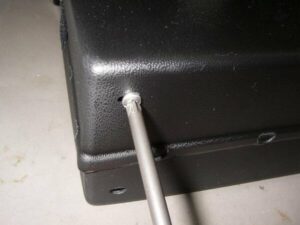
- Pull out the black plastic rivets from the rear of the case and remove the cover, then remove the ribbon cable:
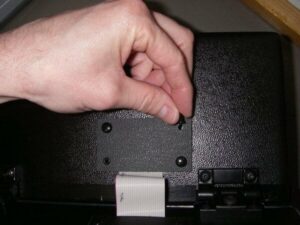
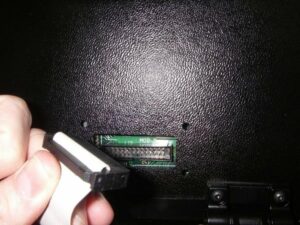
- Pull the main chassis out from the black case:
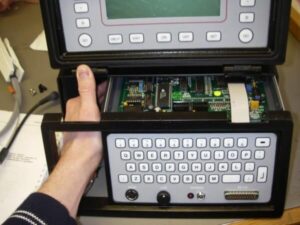
- Turn the chassis upside down and unscrew the nut and screw that are highlighted (note: these may be quite stiff to undo)
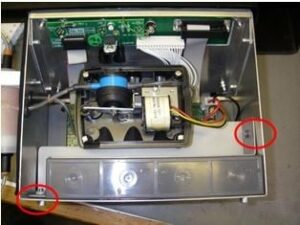
- Pull off the battery connector from the main PCB:
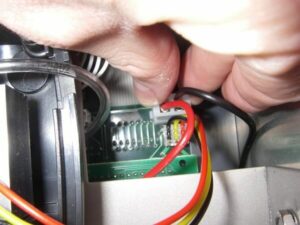
- Push the battery strengthening bracket away from the battery and remove the battery (note: it is a tight fit so it will need some wiggling and some strength to get it out):
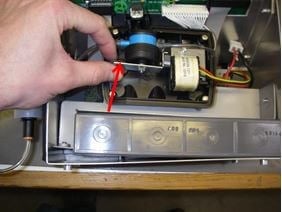
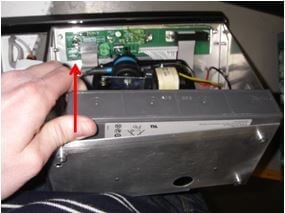
- If the battery is still too snug inside its bracket, try pushing it out from the top. First of all remove the main PCB by pulling out the plastic rivets…
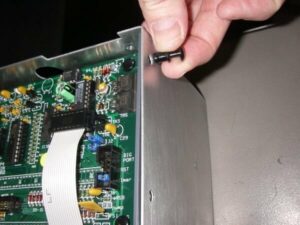
…Then by disconnecting the cables that attach to it (please observe anti-static precautions when handling any PCB):
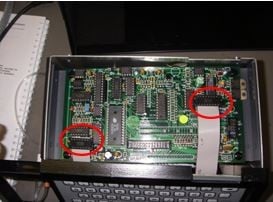
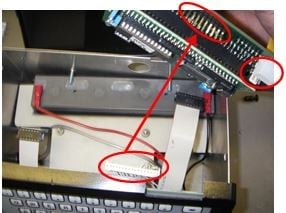
…then push down on the battery to ease it out:
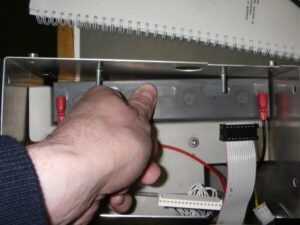
- Remove the battery:
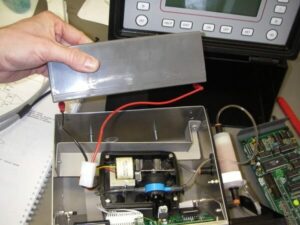
- To fit a new battery in place, do the same procedure in reverse
-
Can the AP4 Porometer provide direct readings of transpiration rate?
Question
Can the AP4 Porometer provide direct readings of transpiration rate?
Answer
We are frequently asked about making measurements of transpiration with the AP4.It is possible to convert from conductance readings to transpiration readings, and the basic equation used to define conductance will do this (see the AP4 technical manual, page 6):
E = cv (wvdc – wvdl)
where E = flux density of water vapour, in g m-2 s-1,
cv = conductance in velocity units, m s-1,
wvdc = water vapour density, at the cup RH and temperature, g m-3.
wvdl = water vapour density, at the leaf RH and temperature, g m-3.However, this measurement will only apply to the conditions within the cup itself. It cannot be used as a basis for calculating the transpiration loss from a plant or canopy because the leaf temperature, air temperature, vapour pressure deficit and boundary layer conductance will all be different in the cup from in the field. We don’t include the option to measure transpiration rate in the AP4 so that users are not tempted to make this extrapolation.
In fact, although the ability to take a reading in transpiration units is built into the LI-COR LI1600, they also strongly recommend that it is not used as a basis for calculating in situ transpiration loss, and instead make the calculation based on the diffusion conductance. The paper published by Dale McDermitt at LI-COR (McDermitt, D.K., 1990.Sources of Error in the Estimation of Stomatal Conductance and Transpiration from Porometer Data.HortScience 25: 1538-1548) contains a very good explanation of how to do this.
-
What is the specification of the AP4 Porometer blotting pads?
Question
What is the specification of the AP4 Porometer blotting pads?
Answer
In general the paper pad material for the AP4 calibration plate is not critical, as long as it is completely clean and grease free.
Filter or blotting paper is good. It is absorbent and will not contaminate the water used. Make sure it is a paper-based filter, not plastic. The finer the fibres in the paper the more water it will hold and the longer it will last before becoming dry.
We currently use blotting pads 32x60mm in size.
-
How do I set up my USB to RS232 convertor? – Photo Guide
Question
How do I set up my USB to RS232 convertor? - Photo Guide
Answer
- These convertors usually come with a website link to visit and download the drivers. Please make sure you download the drivers. Then follow all the on-screen instructions correctly.
- If you have purchased the device from Delta-T, you can download the drivers from here: https://www.dropbox.com/s/2pu0ll8b26y8qkm/CDM212364_Setup.exe?dl=0 or here: https://ftdichip.com/drivers/vcp-drivers/
- Once the drivers have been installed correctly, plug the USB convertor into a USB port on your PC.
- The computer will then assign the convertor a COM port. You will need to check which com port has been assigned via the computer’s “device manager”:
Windows 10
Use the search tool in the bottom task bar to search for ‘device manager’:
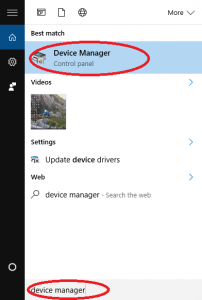
Windows 8
Right click on Desktop background and select ‘All Apps’Right click on control panel and select ‘properties’:
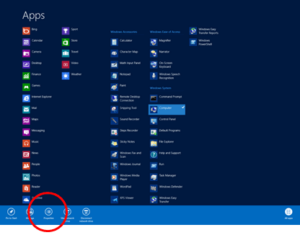
Click on Device Manager:
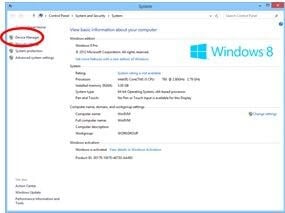
Windows 7
Click on Start, Control Panel, Device Manager:

XP
Click on Start, Control Panel, System:
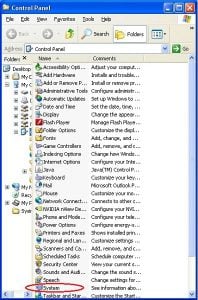
Under the ‘Hardware’ tab, click on ‘Device Manager’:
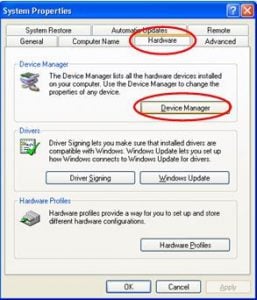
- Once in the device manager, expand the “ports” option. The example below shows a P.C which has the USB to serial converter installed (COM3):
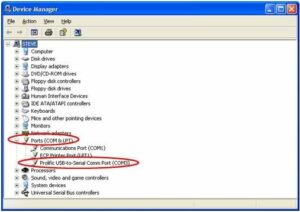
- Please make sure that you use this same COM port number in the device software e.g. HH2read, SunRead, LS2win, DeltaLINK, AP4 retrieve.
- You will probably have to re-boot the P.C once the drivers have been installed.
- Also, please remember to use the original RS232 cable, that was supplied with your device, in series with the RS232 to USB converter.
Multiple USB convertor Installations check
If you have more than one USB to RS232 convertor installed, you can check which COM port has been assigned to the one you want to use, by doing the following:
- Unplug the USB convertor
- Open Device Manager > Ports (COM & LPT)
- Plug in the USB connector and observe which COM port is added to the list.
Product Comparisons
- AP4 Porometer - Product Comparison with METER Group Leaf Porometer SC-1DownloadFilename: AP4-SC1_comparison_ver_6_2025
Regulatory Information
- AP4 Porometer EC Declaration of ConformityDownloadFilename: AP4 Porometer


